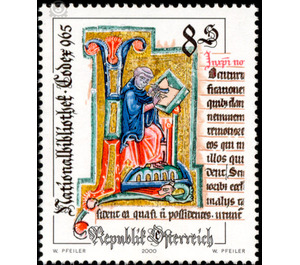Old craft - Austria / II. Republic of Austria 2000 - 8 Shilling
Theme: Art & Culture
| Country | Austria / II. Republic of Austria |
| Issue Date | 2000 |
| Face Value | 8.00 |
| Printing Type | combination printing |
| Stamp Type | Commemorative |
| Item Type | Stamp |
| Chronological Issue Number | 1672 |
| Chronological Chapter | OOS-OE2 |
| SID | 225858 |
| In 56 Wishlists | |
The image reproduced in the stamp, which dates from a manuscript of the late 13th century, shows the author Hugo de Folieto (12th century) as a monk with tonsure and a wide hooded coat in a highly medieval style. He leans over the desk where the sheets to be written are lying. With his left hand he holds an eraser, which serves to make corrections and prevent the blades from folding. In the right hand, the writer holds the obliquely cut quill pen. The codex 965, written in Vienna, contains several texts of theological content, including authors such as Hugo de Folieto, Hugo de S Victore and Anselmus Cantuariensis. The manuscript is decorated with a cover color initial and several Fleuronnée Lombards. It comes from the Vienna Schottenkloster, where the codex has been traceable since the Middle Ages. From there, the parchment codex, consisting of 135 leaves (about 28 x 19 cm), entered the Viennese court library in the 16th century.


